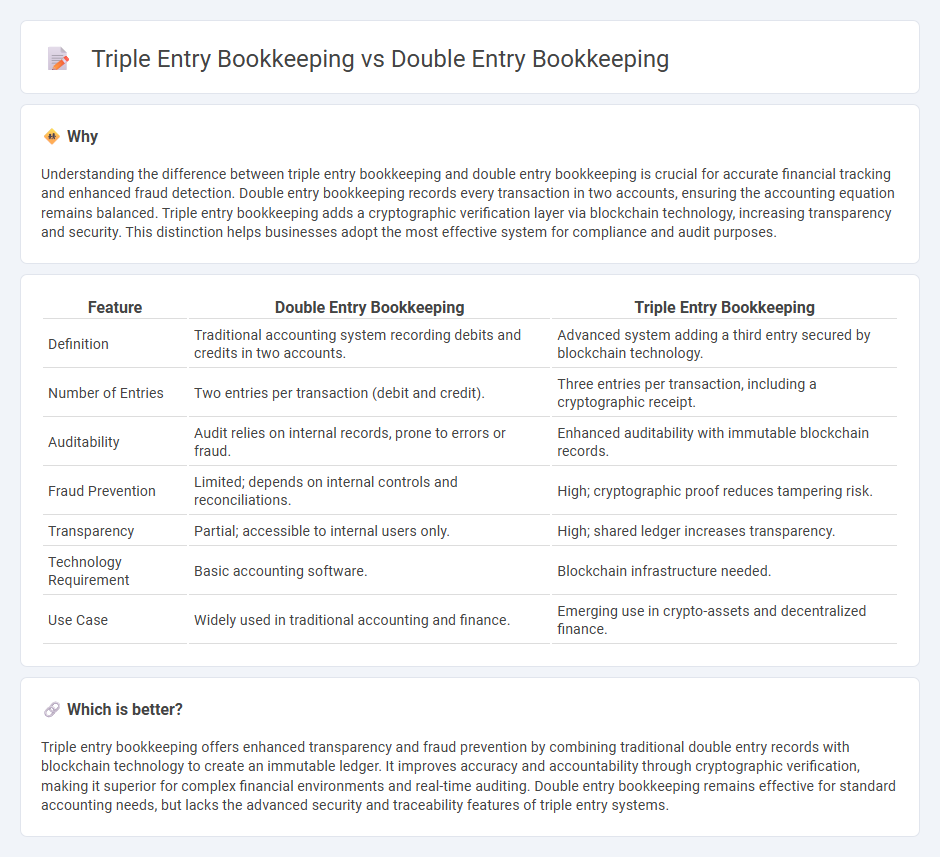
Triple entry bookkeeping enhances financial accuracy by incorporating a cryptographic receipt in addition to traditional debit and credit entries, creating an immutable ledger that reduces fraud and errors. Double entry bookkeeping records transactions through equal debit and credit entries, ensuring balanced accounts but with less transparency and auditability. Discover how triple entry bookkeeping revolutionizes accounting with blockchain technology.
Why it is important
Understanding the difference between triple entry bookkeeping and double entry bookkeeping is crucial for accurate financial tracking and enhanced fraud detection. Double entry bookkeeping records every transaction in two accounts, ensuring the accounting equation remains balanced. Triple entry bookkeeping adds a cryptographic verification layer via blockchain technology, increasing transparency and security. This distinction helps businesses adopt the most effective system for compliance and audit purposes.
Comparison Table
| Feature | Double Entry Bookkeeping | Triple Entry Bookkeeping |
|---|---|---|
| Definition | Traditional accounting system recording debits and credits in two accounts. | Advanced system adding a third entry secured by blockchain technology. |
| Number of Entries | Two entries per transaction (debit and credit). | Three entries per transaction, including a cryptographic receipt. |
| Auditability | Audit relies on internal records, prone to errors or fraud. | Enhanced auditability with immutable blockchain records. |
| Fraud Prevention | Limited; depends on internal controls and reconciliations. | High; cryptographic proof reduces tampering risk. |
| Transparency | Partial; accessible to internal users only. | High; shared ledger increases transparency. |
| Technology Requirement | Basic accounting software. | Blockchain infrastructure needed. |
| Use Case | Widely used in traditional accounting and finance. | Emerging use in crypto-assets and decentralized finance. |
Which is better?
Triple entry bookkeeping offers enhanced transparency and fraud prevention by combining traditional double entry records with blockchain technology to create an immutable ledger. It improves accuracy and accountability through cryptographic verification, making it superior for complex financial environments and real-time auditing. Double entry bookkeeping remains effective for standard accounting needs, but lacks the advanced security and traceability features of triple entry systems.
Connection
Double entry bookkeeping records financial transactions using debits and credits across two accounts, establishing a balanced ledger. Triple entry bookkeeping enhances this system by incorporating a cryptographic receipt for every transaction, creating a third entry that links both parties involved and ensures transparency. This innovation increases security and accuracy in accounting by providing an immutable audit trail beyond traditional double entry methods.
Key Terms
Double Entry Bookkeeping:
Double entry bookkeeping records financial transactions in two accounts, debiting one and crediting another, ensuring balance and accuracy in financial statements. It relies on the accounting equation (Assets = Liabilities + Equity) to maintain integrity and detect errors easily. Learn more about how double entry bookkeeping improves financial transparency and control.
Debit and Credit
Double entry bookkeeping records each financial transaction with equal debits and credits to maintain balance and accuracy, ensuring every debit entry has a corresponding credit entry. Triple entry bookkeeping extends this by introducing a cryptographic receipt for each transaction, enhancing transparency and security across all parties involved. Explore how triple entry bookkeeping revolutionizes the traditional debit and credit system for more reliable financial management.
Ledger
Double entry bookkeeping records each financial transaction in two accounts, ensuring the ledger maintains balanced debits and credits for accurate financial tracking. Triple entry bookkeeping enhances this by incorporating a third, cryptographically secured ledger entry, providing improved transparency, traceability, and fraud prevention. Explore how these ledger systems revolutionize financial record-keeping and security to deepen your understanding.
Source and External Links
What is Double-Entry Bookkeeping? - Dummies.com - Double-entry bookkeeping is a method where each transaction is recorded twice: once as a debit and once as a credit, keeping the accounting equation Assets = Liabilities + Equity in balance by adjusting affected accounts such as cash and furniture for a purchase.
Double-Entry Accounting: What It Is and Why It Matters - NerdWallet - This bookkeeping system records two entries (one debit and one credit) for every transaction, ensuring that debits and credits always balance and providing a complete picture of assets, liabilities, equity, revenue, and expenses.
What Is Double-Entry Bookkeeping? A Simple Guide for Small ... - FreshBooks - Double-entry bookkeeping requires all transactions to be recorded in at least two accounts with equal total debits and credits, maintaining the accounting equation where assets equal liabilities plus equity, which is fundamental for accurate financial statement preparation.
 dowidth.com
dowidth.com